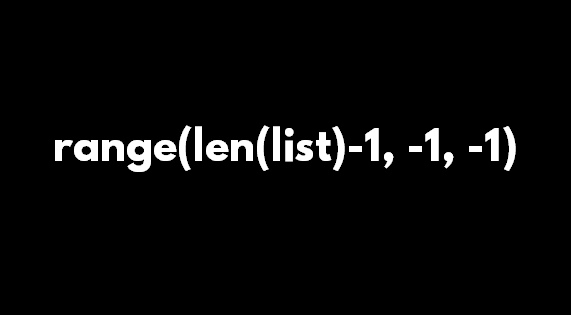
Open-Source Internship opportunity by OpenGenus for programmers. Apply now.
In this article, we have explained the Python code snippet "range(len(list)-1, -1, -1)" and other variants of the code snippet.
In short, the for loop in Python "for i in range(len(list)-1, -1, -1)" is used to loop through all elements of a list in reverse order that is from end to first.
for i in range(len(list)-1, -1, -1):
# do something like learning at OpenGenus
We will start with a basic for loop in Python and incrementally change the code to arrive to Range len-1 in Python.

Table of contents:
- Range in Python
- range(len(list))
- range(len(list)-1)
- range(len(list)-1, 0, -1)
- range(len(list)-1, -1, -1)
Range in Python
Range is a built-in function in Python that is used to generate a list of numbers. The structure of range is as follows:
range(starting_index, last_index, increment)
- starting_index: This is optional and the default value is 0.
- last_index: This is the value at which the iteration or list need to be stopped. This is a complusory parameter.
- increment: This is the value by which the starting index is incremented at each step. This is optional and the default value is 1.
This generates a list of numbers starting with the number "starting_index", incrementing with value "increment" and ending before the number "last_index".
If range(2, 6, 1), then the sequence is:
2, 3, 4, 5
If range(9, 15, 2), then the sequence is:
9, 11, 13
range(len(list))
As only the ending index is complusory, then if one number is provided to range() then the starting number is set to 0 and increment is set to 1.
range(len(list)) is used to generate all sequence of indices in a list as the ending number is length of the list and the starting index is 0 so that last index is length-1.
Consider the following Python code snippet:
list = [10, 5, 99, -90, 12]
for i in range(len(list)):
print("Index ", i, ": ", list[i])
print()
Following will be the output of the above Python code:
Index 0 : 10
Index 1 : 5
Index 2 : 99
Index 3 : -90
Index 4 : 12
range(len(list)-1)
In this variant, we have updated len(list) to len(list)-1 that is we are eliminating the last element of the list.
Consider the following Python code snippet:
list = [10, 5, 99, -90, 12]
for i in range(len(list)-1):
print("Index ", i, ": ", list[i])
print()
Following will be the output of the above Python code:
Index 0 : 10
Index 1 : 5
Index 2 : 99
Index 3 : -90
Note the last element at index 4 which is 12 is not printed.
range(len(list)-1, 0, -1)
In this variant, we have provided all parameters. The starting index is the last index of the list and sequence will terminate when 0 is generated. The increment is -1 that is the sequence is decremented by 1 at each step.
This will generate the indices of the list in reverse order but not as the index starts from 0 and the sequence will end when 0 is generated, the first index of the list will not be generated.
Consider the following Python code snippet:
list = [10, 5, 99, -90, 12]
for i in range(len(list)-1, 0, -1):
print("Index ", i, ": ", list[i])
print()
Following will be the output of the above Python code:
Index 4 : 12
Index 3 : -90
Index 2 : 99
Index 1 : 5
Note the first element that is at index 0 which is 10 is not printed.
range(len(list)-1, -1, -1)
This is the final variant where there are multiple -1s. As explained by the syntax, the starting element is len(list)-1 that is the last index of the list.
-1 is the increment factor so this will decrement the values by 1 at each step.
The sequence will stop when -1 is generated so the last element will be 0 which is the first index of the list.
Hence, this will generate the list of indices of list in reverse order. This can be used to print a list in reverse order.
Consider the following Python code snippet:
list = [10, 5, 99, -90, 12]
for i in range(len(list)-1, -1, -1):
print("Index ", i, ": ", list[i])
print()
Following will be the output of the above Python code:
Index 4 : 12
Index 3 : -90
Index 2 : 99
Index 1 : 5
Index 0 : 10
Note that the elements of the list has been printed in reverse order.
With this article at OpenGenus, you must have the complete idea of range(len(list)-1, -1, -1) in Python.
